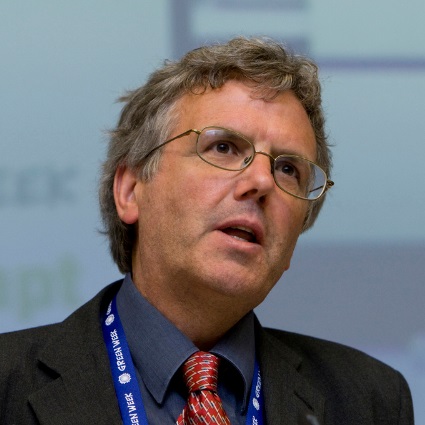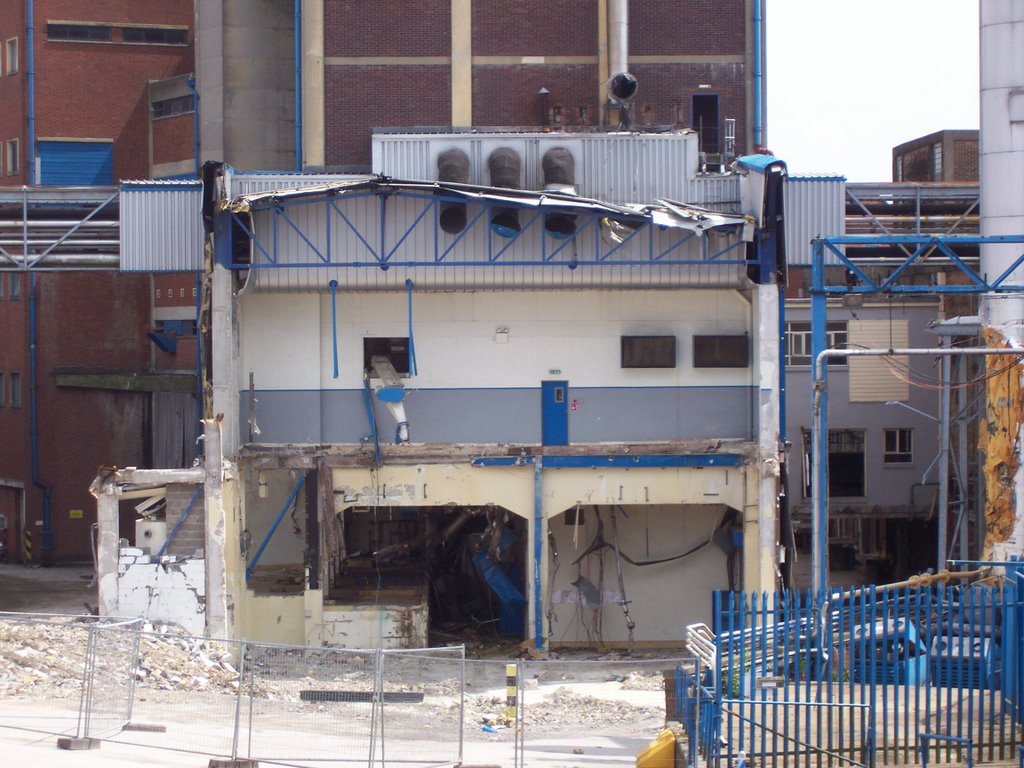Prof. David Manning on Rock Dust: Quarries, Breweries and Beyond

Prof. David Manning
One researcher who is currently investigating the complex relationship between soil and climate is Prof. David Manning, Professor of Soil Sciences at Newcastle University in the UK. He studies how mineral reactions benefit soils in agricultural and urban areas. Manning is particularly interested in the interaction between biology and geology that takes place in soils. His latest research examines the role of mineralogy in addressing some of the most pressing issues of our times: how can we feed the growing world population, and how can we fight climate change?
Break
The fertilizer triad: N-P-K
Fertilizers underpin soil productivity in modern agriculture. Both organic and conventional agriculture require fertilizer, specifically nitrogen, phosphorus, and potassium along with numerous trace elements. Nitrogen gas makes up 78% of the air we breathe, but plants can’t use it directly. For plants to absorb nitrogen, it has to be converted into a bioavailable form, such as ammonia or nitrate. In conventional agriculture, this is done through the Haber-Bosch process which requires methane as an input. Methane is a potent greenhouse gas that contributes to climate change. Fortunately, plants developed their own method for extracting nitrogen from the atmosphere long before the Haber-Bosch process was invented. Plants have evolved alongside microbes and fungi in the soil, and through chemical signaling, plants stimulate soil microorganisms to convert nitrogen into a form they can use. Organic fertilizers take advantage of this natural pathway and might be supplemented by other organic materials (such as guano).
Phosphorus and potassium fertilizers are both derived primarily from minerals. Phosphorus is found in minerals such as apatite but can also be recycled from organic material such as manure. The amount of phosphate fertilizer used each year roughly balances out the amount of phosphorus being harvested from soils through agriculture.
While the production and removal of nitrogen and phosphorus are balanced on a global scale, the same cannot be said for potassium. The main source of conventional potassium fertilizer is potash, a term that encompasses a variety of potassium-bearing salts. Deposits of potash salts occur predominantly in the northern hemisphere, putting farmers in the southern hemisphere at a disadvantage. Increasing demand for potash and limited supply have caused prices to skyrocket. From 1972 to 2014, the price of potash increased 824% effectively pricing many farmers out of the market, especially in poorer countries in the southern hemisphere and Africa in particular.
Break
Helping farmers find sources of potassium
Finding an economic and practical solution to the potassium deficit led Prof. Manning to explore the use of potassium-bearing minerals in the form of rock dust. He noted that in Africa, “It’s normal that farmers don’t have access to global markets for fertilizer because of the price.” Subsidy programs fall short of enabling farmers to move beyond subsistence agriculture. With a local, inexpensive option like rock dust fertilizers, subsistence farmers can increase crop yields and feed not only themselves but produce a surplus to bring to market. In this way, rock dust energizes both the soil and the local economy.
Prof. Manning concentrated his search on a type of igneous rock called nepheline syenite because of its fast dissolution rate (i.e. the rate at which the mineral breaks down into its chemical parts). Other rocks might be more abundant in potassium, but the dissolution rate is what determines a rock’s effectiveness as a mineral fertilizer—it won’t do any good if plants can’t get to it. Availability is also important when identifying an appropriate source rock for remineralization. He notes, “nepheline is a rare mineral, but it’s very common in East Africa.”
The problem of feeding the world’s growing population in a sustainable manner requires a tailored approach that’s unique to the requirements and limitations of each location. There’s no single solution that will work everywhere. In South America, Prof. Manning identified phonolite as a potential source of potassium. Phonolite, the volcanic equivalent of nepheline syenite, is present in Brazil and elsewhere as ash deposits. Ash layers can occur over large areas making them a readily available source of minerals.
In areas where nepheline bearing rocks are unavailable, other minerals such as feldspar or biotite may work instead. Potassium feldspars have proven cost effective in Egypt, for example, but in other places have shown only limited benefits. Pot trials with biotite suggest it may be as effective as potash. Deciding which potassium fertilizer to use requires a farmer to weigh the costs and benefits. The low cost and wide availability of rock dust fertilizers make them an attractive alternative to potash, especially in the southern hemisphere.
Break
Rock dust in the soils: The underlying processes
Prof. Manning’s interest in rock dust goes beyond fertilizer. Rock dust is also an effective means of removing carbon dioxide from the atmosphere and storing it for long periods of time in the soil through a process called carbon sequestration. This occurs in two ways—weathering and carbonation.

The Scottish and Newcastle Brewery, partially demolished.
If there is a sufficient amount of calcium released, the soil will undergo a process called carbonation which uses a different mechanism to sequester carbon. In contrast to enhanced weathering which produces dissolved ions, carbonation produces a solid mineral, usually calcium carbonate (calcite), which remains in the soil. Carbonation requires an abundance of calcium to produce the solid mineral. When the water in the soil becomes saturated with calcium, carbonate minerals will start to form even in slightly acidic conditions such as those encountered in most soils.
The bicarbonate ions are washed out of the soil and eventually make their way into the ocean, where they buffer the acidity. Ocean acidification is another detrimental effect of climate change, and enhanced weathering is an effective means to counteract it. Once in the ocean, the bicarbonate ions will remain there for long periods of time, safely sequestering carbon.
The minerals found in rocks provide the elements necessary for carbon sequestration to take place in soils. The smaller the rock fragments are, the faster these reactions take place, so finely ground rock dust is ideal. However, there is a limit to how far one can take this. If the goal is to remove as much carbon dioxide from the atmosphere as possible, then the carbon emissions associated with the entire life cycle of the rock dust must be considered. This includes grinding and transporting the rock. Fortunately, most commercial quarries already produce rock dust as a by-product of their operations.
Break
A case study: Urban demolition carbon capture

Crumbling sign on the old Scottish & Newcastle plc building
Manmade materials like crushed concrete will react with the carbon dioxide in the air to form stable soil carbonates after just a few years, but they won’t do it on their own. Plants are the key to transforming waste into a carbon capture product. Without the plants, the crushed concrete reacts too slowly to impact climate change. Without the concrete, the carbon in the plants might be released back into the atmosphere as the plants decompose. By mixing these materials into the soil, “you’ve put them in a very hungry environment.” The crushed concrete provides nutrients for the plants to grow. Plants pull carbon dioxide through their roots into the soil where it can react with the crushed cement. They also secrete organic acids and enzymes which speed up the process. “By getting the nutrients out of the rock, [the plants] are helping to take CO2 out of the atmosphere.”
Prof. Manning measured carbon dioxide sequestration rates of 85 tonnes per hectare per year at the demolition site. That’s faster than rates observed for most natural minerals and equal to the annual carbon footprint of 16 people in the UK. While these results are impressive, Prof. Manning points out that the benefits are limited by the amount of carbon dioxide emitted during manufacturing. “All you are able to do is put back the CO2 that was driven off when you made the cement.” At best, this is a carbon neutral process.
Break
Measuring carbon sequestration in soils
One of the challenges of evaluating rock dust for carbon sequestration is measuring how much carbon is actually removed from the atmosphere. Soils are open systems that interact with the air, water, and biota around them. Sequestration means removing carbon dioxide from the atmosphere for a long time, but it doesn’t mean the carbon has to stay in one place. Water can move bicarbonate out of the soil into the oceans. Top dressing can be blown away by the wind. People remove carbon from the land by harvesting crops and timber.
Soils can also be very thick or very shallow, and climate plays a big role in determining where carbon is deposited within the soil profile. It’s hard to know where to look. “It’s very, very hard to verify the process with a soil sample.” Finding a way to measure accurately the amount of carbon sequestered in soils is one of Prof. Manning’s key research goals going forward. Measuring soil carbon will help determine which sequestration methods are most effective and establish a baseline for carbon offset credits.
How the carbon is stored in the soil is important, too. “Soils will generally be emitting CO2 through the biological activity that takes place within them.” It’s important to remember that plants store about half of their carbon underground. The organic carbon stored above ground in stems and leaves is easily released back into the atmosphere as carbon dioxide (for example, when it is metabolized by microbes). This is why gardeners need to add new compost every year; it doesn’t stick around.
The carbon stored below ground is available for sequestration, but only if the soil conditions allow for it. The factor that determines whether the plant-soil system will sequester carbon is the availability of calcium (and other cations to a lesser extent) from mineral sources. “This gives you a sink that helps reduce the net emissions.” The inorganic carbon found in minerals can stay in the soil indefinitely. We know this because these types of pedogenic (soil-based) carbonates appear in the historic rock record. The same process that created carbonates in prairie soils millions of years ago is still at work in modern soils today.
Break
The future of carbon capture with rock dust
Looking forward, Prof. Manning is very excited about his partnership with REMIN (Scotland) Ltd. REMIN rock dust is certified to be free of contaminants and safe for food production. This opens the opportunity to study the relationship between rock dust as a fertilizer and rock dust as a carbon sequestration method. “What we’re really keen to do is to see the carbon approach being used in what’s called carbon capture gardens.” These are an urban approach to carbon capture, easily accessible to amatuer gardeners and even kids. When it comes to a problem as large as climate change, every little bit helps, even a backyard garden.
In addition to increasing public awareness about the benefits of rock dust, Prof. Manning would like to see remineralization become part of the urban planning process. “The planning system is already set up for quarrying the right sort of rock [in the UK].” Aggregate quarries produce a powdery dust called quarry fines as a byproduct of their operations. Quarry fines are perfect for carbon capture, because they have a lot of surface area, making them very reactive. Prof. Manning wants to capture this available material and put it to use in the fight against climate change.
Through his research, David Manning is ushering in a new era in which rock dust plays an integral part in solving some of the most perplexing challenges of our time. While the biological and geochemical science that underpins it is complex, in practice it’s quite simple: Remineralizing the soil will provide us with healthy plants and a stable climate for years to come.
Break
David Manning is a geologist by training, now Professor of Soil Science at Newcastle University. He holds an Honorary Chair in the School of Geosciences at Edinburgh University. His research focuses on carbon capture in natural and artificial soils (carbonation and biochar), and on both shallow and deep geothermal energy. (Bio taken from https://epsrc.ukri.org/about/people/david-manning/.)
Break
Debbie Patskowski is a senior petrophysicist and freelance writer on Medium, covering such topics as geology, science, and space exploration. Her professional areas of expertise include identification of minerals, rock types, and pore fluids using remote sensing (borehole) measurements. She has a BS in Geology and Environmental Sciences from Stanford and an MBA from the German University in Cairo. She and her husband live in Colorado where she enjoys running and hiking in the Rocky Mountains.
Break
References
Abbott, Lynette K., and David AC Manning. “Soil health and related ecosystem services in organic agriculture.” Sustainable Agriculture Research 4, no. 526-2016-37946 (2015).
Lefebvre, David, Pietro Goglio, Adrian Williams, David AC Manning, Antonio Carlos de Azevedo, Magda Bergmann, Jeroen Meersmans, and Pete Smith. “Assessing the potential of soil carbonation and enhanced weathering through Life Cycle Assessment: A case study for Sao Paulo State, Brazil.” Journal of cleaner production 233 (2019): 468-481.
Manning, D. A. C. “Biological enhancement of soil carbonate precipitation: passive removal of atmospheric CO2.” Mineralogical Magazine 72, no. 2 (2008): 639-649.
Manning, David AC. “How will minerals feed the world in 2050?.” Proceedings of the Geologists’ Association 126, no. 1 (2015): 14-17.
Manning, David AC. “Mineral sources of potassium for plant nutrition. A review.” Agronomy for sustainable development 30, no. 2 (2010): 281-294.
Manning, David AC, and Phil Renforth. “Passive sequestration of atmospheric CO2 through coupled plant-mineral reactions in urban soils.” Environmental science & technology 47, no. 1 (2013): 135-141.
Manning, David AC. “Phosphate minerals, environmental pollution and sustainable agriculture.” Elements 4, no. 2 (2008): 105-108.
Manning, David AC, Philip Renforth, E. Lopez-Capel, S. Robertson, and N. Ghazireh. “Carbonate precipitation in artificial soils produced from basaltic quarry fines and composts: An opportunity for passive carbon sequestration.” International Journal of Greenhouse Gas Control 17 (2013): 309-317.
Manning, David AC, Joana Baptista, Mallely Sanchez Limon, and Kirsten Brandt. “Testing the ability of plants to access potassium from framework silicate minerals.” Science of the total environment 574 (2017): 476-481.
Renforth, P., C-L. Washbourne, J. Taylder, and D. A. C. Manning. “Silicate production and availability for mineral carbonation.” (2011): 2035-2041.
Renforth, Philip, D. A. C. Manning, and E. Lopez-Capel. “Carbonate precipitation in artificial soils as a sink for atmospheric carbon dioxide.” Applied Geochemistry 24, no. 9 (2009): 1757-1764.
Schmidt, Michael WI, Margaret S. Torn, Samuel Abiven, Thorsten Dittmar, Georg Guggenberger, Ivan A. Janssens, Markus Kleber et al. “Persistence of soil organic matter as an ecosystem property.” Nature 478, no. 7367 (2011): 49-56.
Washbourne, Carla-Leanne, Elisa Lopez-Capel, Phil Renforth, Philippa L. Ascough, and David AC Manning. “Rapid removal of atmospheric CO2 by urban soils.” Environmental science & technology 49, no. 9 (2015): 5434-5440.
Washbourne, C-L., Philip Renforth, and D. A. C. Manning. “Investigating carbonate formation in urban soils as a method for capture and storage of atmospheric carbon.” Science of the total environment 431 (2012): 166-175.
Support us on Patreon
Thank you for joining us today! Please become a member of RTE and support us on Patreon. Unlike many larger organizations, we work with a team of determined and passionate volunteers to get our message out. We aim to continue to increase the awareness of remineralization to initiate projects across the globe that remineralize soils, grow nutrient dense food, regenerate our forests’ and stabilize the climate – with your help! If you can, please support us on a monthly basis from just $2, rest assured that you are making a big impact every single month in support of our mission. Thank you!








Got something to say?